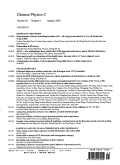- 钛学术文献服务平台 \
- 学术期刊 \
- 基础科学期刊 \
- 物理学期刊 \
- 中国物理C(英文版)期刊 \
null
Physics potential of searching for 0νββ decays in JUNO
基本信息来源于合作网站,原文需代理用户跳转至来源网站获取
摘要:
In the past few decades,numerous searches have been made for the neutrinoless double-beta decay (0νββ) process,aiming to establish whether neutrinos are their own antiparticles (Majorana neutrinos),but no 0νβ β decay signal has yet been observed.A number of new experiments are proposed but they ultimately suffer from a common problem:the sensitivity may not increase indefinitely with the target mass.We have performed a detailed analysis of the physics potential by using the Jiangmen Underground Neutrino Observatory (JUNO) to improve the sensitivity to 0νββ up to a few meV,a major step forward with respect to the experiments currently being planned.JUNO is a 20 kton low-background liquid scintillator (LS) detector with 3%/√E(Mev) energy resolution,now under construction.It is feasible to build a balloon filled with enriched xenon gas (with 136Xe up to 80%) dissolved in LS,inserted into the central region of the JUNO LS.The energy resolution is~1.9% at the Q-value of 136Xe 0νββ decay.Ultra-low background is the key for 0νββ decay searches.Detailed studies of background rates from intrinsic 2νββ and 8B solar neutrinos,natural radioactivity,and cosmogenic radionuclides (including light isotopes and 137Xe) were performed and several muon veto schemes were developed.We find that JUNO has the potential to reach a sensitivity (at 90% C.L.) to T1/20νββ of 1.8 x 1028 yr (5.6 × 1027 yr) with~50 tons (5 tons) of fiducial 136xe and 5 years exposure,while in the 50-ton case the corresponding sensitivity to the effective neutrino mass,mββ,could reach (5-12) meV,covering completely the allowed region of inverted neutrino mass ordering.

推荐文章
期刊_丙丁烷TDLAS测量系统的吸收峰自动检测
带间级联激光器
调谐半导体激光吸收光谱
雾剂检漏 中红外吸收峰 洛伦兹光谱线型
不同盐度、温度及光照对漂浮浒苔生理生态的影响
浒苔
盐度
温度
光照
生理生态
期刊_联合空间信息的改进低秩稀疏矩阵分解的高光谱异常目标检测
高光谱图像
异常目标检测 低秩稀疏矩阵分解 稀疏矩阵 残差矩阵
内容分析
关键词云
关键词热度
相关文献总数
(/次)
(/年)
文献信息
| 篇名 | Physics potential of searching for 0νββ decays in JUNO | ||
| 来源期刊 | 中国物理C(英文版) | 学科 | |
| 关键词 | |||
| 年,卷(期) | 2017,(5) | 所属期刊栏目 | |
| 研究方向 | 页码范围 | 6-15 | |
| 页数 | 10页 | 分类号 | |
| 字数 | 语种 | 英文 | |
| DOI | 10.1088/1674-1137/41/5/053001 | ||
五维指标
引文网络
引文网络
二级参考文献 (0)
共引文献 (0)
参考文献 (1)
节点文献
引证文献 (0)
同被引文献 (0)
二级引证文献 (0)
2007(1)
- 参考文献(1)
- 二级参考文献(0)
2017(0)
- 参考文献(0)
- 二级参考文献(0)
- 引证文献(0)
- 二级引证文献(0)
引文网络交叉学科
相关学者/机构
期刊影响力
中国物理C(英文版)
主办单位:
中国物理学会
中国科学院高能物理研究所
中国科学院近代物理研究所
出版周期:
月刊
ISSN:
1674-1137
CN:
11-5641/O4
开本:
出版地:
北京市玉泉路19号(乙)中国科学院高能物理研究所内 北京918信箱
邮发代号:
创刊时间:
语种:
eng
出版文献量(篇)
3629
总下载数(次)
0
总被引数(次)
2764
期刊文献
相关文献
推荐文献
- 期刊分类
- 期刊(年)
- 期刊(期)
- 期刊推荐
力学
化学
地球物理学
地质学
基础科学综合
大学学报
天文学
天文学、地球科学
数学
气象学
海洋学
物理学
生物学
生物科学
自然地理学和测绘学
自然科学总论
自然科学理论与方法
资源科学
非线性科学与系统科学
中国物理C(英文版)2022
中国物理C(英文版)2021
中国物理C(英文版)2020
中国物理C(英文版)2019
中国物理C(英文版)2018
中国物理C(英文版)2017
中国物理C(英文版)2016
中国物理C(英文版)2015
中国物理C(英文版)2014
中国物理C(英文版)2013
中国物理C(英文版)2012
中国物理C(英文版)2011
中国物理C(英文版)2010
中国物理C(英文版)2009
中国物理C(英文版)2008
中国物理C(英文版)2017年第9期
中国物理C(英文版)2017年第8期
中国物理C(英文版)2017年第7期
中国物理C(英文版)2017年第6期
中国物理C(英文版)2017年第5期
中国物理C(英文版)2017年第4期
中国物理C(英文版)2017年第3期
中国物理C(英文版)2017年第2期
中国物理C(英文版)2017年第12期
中国物理C(英文版)2017年第11期
中国物理C(英文版)2017年第10期
中国物理C(英文版)2017年第1期

 免费查重
免费查重










